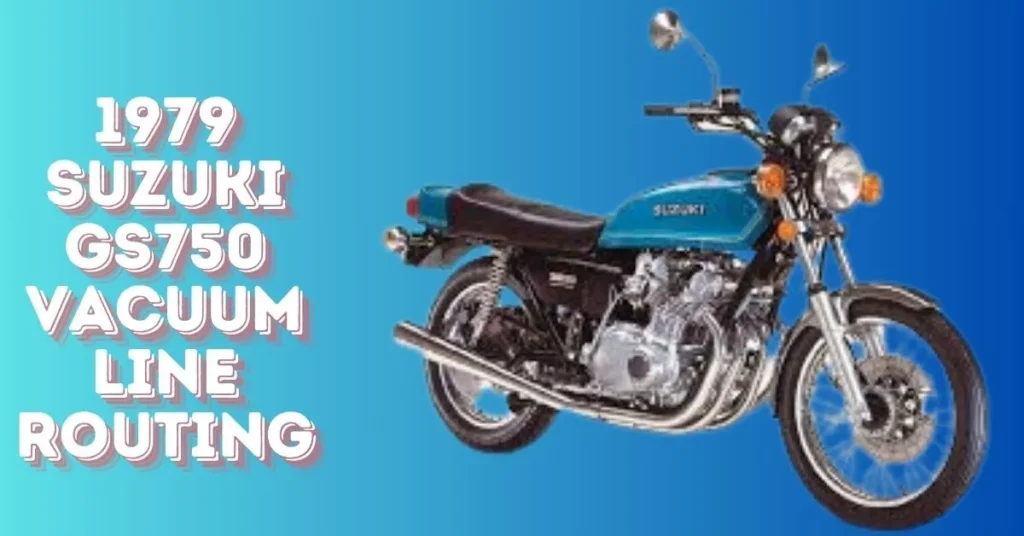The 1979 Suzuki GS750 is a classic motorcycle cherished by enthusiasts and collectors. Known for its reliability and powerful performance, the GS750 remains a popular choice for vintage motorcycle restoration projects. One critical aspect of maintaining this bike is ensuring the correct routing of its vacuum lines. Proper vacuum line routing is essential for the bike’s performance, particularly in maintaining engine efficiency and preventing common issues like poor idling or fuel delivery problems.
Vacuum lines play a vital role in connecting various components of the motorcycle, such as the carburetor and fuel petcock. These lines ensure that the engine receives the correct air-fuel mixture, which is crucial for smooth operation. Incorrect vacuum line routing can lead to several problems, including engine misfires, loss of power, and even long-term damage to the engine. For the 1979 Suzuki GS750, understanding and implementing proper vacuum line routing is a key step in both restoration and regular maintenance.
This blog post aims to provide a comprehensive guide to vacuum line routing specifically for the 1979 Suzuki GS750. Whether you’re a seasoned restorer or new to vintage motorcycle maintenance, this guide will offer step-by-step instructions, tips, and troubleshooting advice. By following this guide, you can ensure that your GS750 runs smoothly and reliably. Additionally, you’ll learn how to identify potential issues caused by incorrect routing and how to fix them effectively. This post will equip you with the knowledge needed to keep your GS750 in top condition, ensuring that it continues to perform at its best for years to come.
Table Of Contents
Understanding Vacuum Line Routing
What Are Vacuum Lines?
Vacuum lines are small rubber hoses that connect various components of the motorcycle’s engine. They carry vacuum pressure from one part of the engine to another, helping to control different systems like the carburetor and fuel petcock. In the 1979 Suzuki GS750, these lines are crucial for the engine’s operation and overall performance.
The vacuum created by the engine’s pistons is used to move fuel from the tank to the carburetor. This vacuum pressure ensures that the right amount of fuel reaches the engine. Without properly routed vacuum lines, the engine can experience problems like poor idling or stalling.
Specific Role of Vacuum Lines in the GS750
In the 1979 Suzuki GS750, the vacuum lines are particularly important because they manage fuel flow and help maintain engine stability. These lines connect the carburetor, fuel petcock, and other components. If these connections are not routed correctly, the engine may not run smoothly or might fail to start.
The vacuum lines also help in controlling emissions by regulating the air-fuel mixture. This is especially important for maintaining the engine’s efficiency and performance. Proper routing ensures that each component receives the correct amount of vacuum pressure.
Common Problems Caused by Incorrect Vacuum Line Routing
Incorrect vacuum line routing can lead to several issues in the Suzuki GS750. One common problem is poor engine performance, where the bike might have trouble idling or accelerating. This can also result in fuel delivery issues, where the engine does not receive the right amount of fuel, causing it to run lean or rich.
Another issue is the potential for vacuum leaks. A leak can reduce the vacuum pressure needed for proper engine function, leading to misfires or stalling. Long-term damage to the engine is also possible if the vacuum lines are not routed correctly, as improper fuel delivery can cause excessive wear on engine components.
Tools and Materials Needed
List of Required Tools
Before you start working on the vacuum lines of your 1979 Suzuki GS750, it’s important to gather all the necessary tools. You’ll need a set of screwdrivers, pliers, and clamps to work on the vacuum lines. Additionally, you should have a vacuum line hose that matches the original specifications of the GS750.
It’s also a good idea to have replacement parts on hand, such as new vacuum lines and connectors. These parts are essential if you find that the existing lines are worn out or damaged. For those who want to be thorough, a vacuum gauge can help you test the vacuum pressure after installation.
Preparation Tips
Setting up your workspace is crucial for a smooth repair process. Make sure you have a clean and well-lit area to work in. This will help you avoid losing small parts and ensure that you can see what you’re doing.
Safety should always be your top priority. Wear gloves to protect your hands from any sharp edges or hot surfaces. Before you start, it’s also wise to disconnect the battery to prevent any accidental electrical issues.
Identifying and Labeling Existing Lines
Before removing any vacuum lines, take the time to identify and label each one. This will make it easier to route the new lines correctly. You can use masking tape and a marker to label the connections, ensuring you don’t mix them up during reinstallation.
Carefully examine the existing lines to check for wear, cracks, or leaks. Identifying the problem areas now will help you decide which lines need to be replaced. This step is essential to ensure that your new vacuum lines are installed correctly and function properly.
Step-by-Step Guide to Vacuum Line Routing
Step 1: Accessing the Vacuum Lines
To begin, you need to access the vacuum lines on your 1979 Suzuki GS750. Start by removing the seat and fuel tank to expose the engine components. This will give you a clear view of the vacuum lines and their connections.
Make sure to handle the tank carefully to avoid damaging any parts. Once the tank is removed, you should be able to see the vacuum lines running between the carburetor, fuel petcock, and other engine components. Take a moment to familiarize yourself with the layout before proceeding.
Step 2: Inspecting Existing Vacuum Lines
Before installing new lines, inspect the existing ones for any signs of damage. Look for cracks, wear, or leaks that could affect performance. If you find any damaged lines, they should be replaced immediately.
Even if the lines appear to be in good condition, it’s still a good idea to replace them if they are old. New lines will ensure a tight seal and optimal performance. This inspection step is crucial to avoid future problems.
Step 3: Mapping the Correct Vacuum Line Routing
Proper routing of vacuum lines is essential for the correct operation of your GS750. Refer to a detailed diagram of the 1979 Suzuki GS750 to ensure each line is connected properly. The vacuum lines should connect the carburetor to the fuel petcock and other necessary components.
When mapping out the routing, make sure the lines are not too long or too short. They should fit snugly without kinks or sharp bends. This will prevent leaks and ensure smooth fuel delivery.
Step 4: Installing New Vacuum Lines
After mapping out the routing, you can begin installing the new vacuum lines. Cut the lines to the appropriate length, making sure they match the original specifications. Secure the lines with clamps to ensure they are tightly connected.
Double-check each connection to make sure it is airtight. An improper connection can lead to vacuum leaks, which will affect the bike’s performance. Take your time during this step to ensure everything is installed correctly.
Step 5: Testing the System
Once the new vacuum lines are installed, it’s important to test the system. Reconnect the fuel tank and battery, then start the engine. Listen for any unusual sounds and check for leaks around the vacuum lines.
If you have a vacuum gauge, use it to measure the vacuum pressure and ensure it’s within the normal range. If everything checks out, your vacuum line routing is complete. This final test will confirm that your 1979 Suzuki GS750 is ready for the road.
Troubleshooting and Maintenance
Common Issues Post-Installation
After installing new vacuum lines, you may encounter some issues. Common problems include vacuum leaks, which can cause poor engine performance or stalling. If you notice any irregularities, double-check all connections to ensure they are secure.
Another issue might be improper fuel delivery. This can happen if the lines are not routed correctly. Ensure that each line is connected to the correct component and is not kinked or pinched.
Regular Maintenance Tips
To keep your vacuum lines in good condition, perform regular inspections. Check for any signs of wear, such as cracks or leaks, and replace damaged lines promptly. Regular maintenance will help you avoid performance issues and ensure the longevity of your GS750.
It’s a good idea to inspect the vacuum lines every few months or before long rides. Make sure the lines are properly secured and that clamps are tight. Regular checks will help you catch problems early and maintain optimal engine performance.
Signs That Vacuum Lines Need Replacement
Certain signs indicate that your vacuum lines may need replacing. Look out for symptoms like rough idling, engine stalling, or poor acceleration. These issues often point to vacuum line problems.
If you notice any of these symptoms, inspect the vacuum lines for damage. Replacing old or worn lines will help resolve these issues and improve your bike’s performance. Regularly replacing vacuum lines is key to keeping your 1979 Suzuki GS750 running smoothly.
Expert Tips and Tricks
Tips from Seasoned GS750 Owners
Experienced GS750 owners have valuable advice for maintaining vacuum lines. Always use a high-quality vacuum hose that matches the original specifications. This ensures a proper fit and reliable performance.
Avoid sharp bends in the vacuum lines. Sharp bends can restrict airflow and cause vacuum leaks. Route the lines as smoothly as possible to maintain consistent pressure.
Upgrades and Modifications
Consider upgrading to silicone vacuum lines for better durability. Silicone lines resist heat and chemicals better than standard rubber hoses. This can be a worthwhile investment for long-term reliability.
If you’re modifying your GS750, ensure that any new components are compatible with the existing vacuum system. Verify that all connections are secure and that the vacuum pressure remains within the correct range. Proper integration of new parts will help maintain optimal engine performance.
Community Resources
Forums and Online Communities
There are several forums and online communities where GS750 enthusiasts share tips and advice. Websites like GS Resources and the Suzuki GS Forum are great places to find information and ask questions. Engaging with these communities can provide additional insights and help you with specific issues.
These forums often have dedicated sections for vacuum line routing and other maintenance topics. You can find detailed guides and discussions about the GS750. Participating in these discussions can also help you connect with other GS750 owners.
Recommended Reading and Videos
For more detailed information, consider checking out additional reading materials and videos. Look for service manuals and repair guides specific to the 1979 Suzuki GS750. These resources often include diagrams and step-by-step instructions.
There are also instructional videos available online that cover vacuum line routing. These videos can provide visual guidance and help you understand the installation process better. Combining written guides with videos can enhance your understanding and ensure proper installation.
Conclusion
Recap of Key Points
Proper vacuum line routing is essential for the optimal performance of your 1979 Suzuki GS750. Ensuring that each line is correctly installed and secured helps maintain engine efficiency and prevent issues. Regular inspections and maintenance will keep your vacuum system in top condition.
Encouragement for DIY Enthusiasts
Working on your GS750 can be a rewarding experience. By following the steps outlined in this guide, you can confidently handle vacuum line routing. Your efforts will help keep your motorcycle running smoothly and reliably.
Call to Action
If you found this guide helpful, consider subscribing to our blog for more motorcycle maintenance tips. Share this post with fellow Suzuki GS750 enthusiasts who might benefit from it. Feel free to leave any questions or comments below; we’re here to help!
Additional Resources
Links to Detailed Guides
For more in-depth information, explore additional guides and manuals related to the 1979 Suzuki GS750. Websites like Suzuki Parts House and Haynes Manuals offer valuable resources. These guides provide comprehensive details on various maintenance tasks and repairs.
Books and Articles
Several books cover vintage motorcycle restoration, including the GS750. Titles like “The Essential Guide to Motorcycle Maintenance” offer practical advice. Reading these books can provide a broader understanding of motorcycle upkeep.
Online Videos and Tutorials
You can find numerous tutorials and how-to videos online. Platforms like YouTube have channels dedicated to motorcycle maintenance. These videos often include step-by-step instructions for tasks like vacuum line routing, making them a useful visual aid.
FAQs
Why is vacuum line routing important for the GS750?
Vacuum line routing is crucial because it ensures proper engine performance and fuel delivery. Incorrect routing can lead to issues like poor idling, stalling, and reduced power.
How often should I inspect the vacuum lines on my GS750?
It’s a good practice to inspect the vacuum lines every few months or before long rides. Regular checks help identify wear or damage early and prevent performance problems.
What are common signs of vacuum line issues?
Common signs include rough idling, engine stalling, and poor acceleration. If you notice any of these symptoms, it’s important to check the vacuum lines for leaks or damage.
Can I use any vacuum line for my GS750?
It’s best to use vacuum lines that match the original specifications for the GS750. High-quality lines designed for your bike will ensure proper fit and performance.
How do I test for vacuum leaks?
You can test for vacuum leaks by visually inspecting the lines for cracks or by using a vacuum gauge. A vacuum gauge helps you check if the pressure is within the normal range. What tools do I need for vacuum line routing?
Essential tools include screwdrivers, pliers, clamps, and vacuum hoses. Having a vacuum gauge on hand can also help with testing the system.
Can I upgrade the vacuum lines on my GS750?
Yes, upgrading to silicone vacuum lines can provide better durability. Silicone lines are more resistant to heat and chemicals compared to standard rubber hoses.







